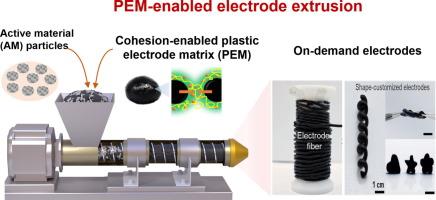Active-material microenvironment engineering by plasticine electrode matrix for shape-customizable Li-ion batteries
IF 14.9
1区 化学
Q1 Energy
引用次数: 0
Abstract
The development of shape-customizable and bulk flexible electrochemical devices through processing technologies as versatile as those used for plastics promises to revolutionize the future of battery technology. However, this pursuit has been fundamentally hindered by the absence of transformative battery materials capable of delivering the necessary electrochemical functions, robust interface adhesion, and, crucially, the suitable rheological properties required for on-demand shaping. In this work, we introduce a concept of a multifunctional plasticine electrode matrix (PEM) featuring nano-interpenetrating networks (nano-IPN) to address this challenge. Utilizing the nonflammable liquid-electrolyte hydration combined with conductive nanomaterials, we have realized a PEM in the form of a multifunctional nanocomposite that integrates ion and electron conduction, component binding, non-flammability, and plasticine-like moldability. With this PEM, we have successfully fabricated a variety of bulk-flexible electrodes with high mass loading of active material (AM) (>70 wt %) using industry-friendly extrusion and compression molding techniques. Moreover, these high AM-loading composite electrodes achieve an unparalleled bulk conformability and flexibility, remaining structurally intact even under severe mechanical stress. Ultimately, we have successfully produced shape-patternable and flexible batteries via extrusion molding. This study underscores the potential of the PEM to revolutionize battery microstructures, interfaces, manufacturing processes, and performance characteristics.

可定制形状锂离子电池的塑料电极基质活性材料微环境工程
通过与塑料一样通用的加工技术,开发出可定制形状和大块柔性电化学装置,有望彻底改变电池技术的未来。然而,由于缺乏能够提供必要的电化学功能、强大的界面附着力以及(至关重要的)按需成型所需的合适流变特性的变革性电池材料,这种追求从根本上受到了阻碍。在这项工作中,我们引入了一种具有纳米互穿网络(纳米ipn)的多功能塑料电极矩阵(PEM)的概念来解决这一挑战。利用不可燃的液体-电解质水合作用与导电纳米材料相结合,我们实现了一种多功能纳米复合材料形式的PEM,它集离子和电子传导、组分结合、不可燃性和类似塑料的可塑性于一体。有了这种PEM,我们已经成功地使用工业友好的挤压和压缩成型技术制造了各种具有高质量活性材料(AM) (>70 wt %)负载的大块柔性电极。此外,这些高am负载复合电极具有无与伦比的整体一致性和柔韧性,即使在严重的机械应力下也能保持结构完整。最终,我们已经成功地通过挤压成型生产出形状图案和柔性电池。这项研究强调了PEM在改变电池微结构、界面、制造工艺和性能特性方面的潜力。
本文章由计算机程序翻译,如有差异,请以英文原文为准。
求助全文
约1分钟内获得全文
求助全文
来源期刊

Journal of Energy Chemistry
CHEMISTRY, APPLIED-CHEMISTRY, PHYSICAL
CiteScore
19.10
自引率
8.40%
发文量
3631
审稿时长
15 days
期刊介绍:
The Journal of Energy Chemistry, the official publication of Science Press and the Dalian Institute of Chemical Physics, Chinese Academy of Sciences, serves as a platform for reporting creative research and innovative applications in energy chemistry. It mainly reports on creative researches and innovative applications of chemical conversions of fossil energy, carbon dioxide, electrochemical energy and hydrogen energy, as well as the conversions of biomass and solar energy related with chemical issues to promote academic exchanges in the field of energy chemistry and to accelerate the exploration, research and development of energy science and technologies.
This journal focuses on original research papers covering various topics within energy chemistry worldwide, including:
Optimized utilization of fossil energy
Hydrogen energy
Conversion and storage of electrochemical energy
Capture, storage, and chemical conversion of carbon dioxide
Materials and nanotechnologies for energy conversion and storage
Chemistry in biomass conversion
Chemistry in the utilization of solar energy
 求助内容:
求助内容: 应助结果提醒方式:
应助结果提醒方式:


